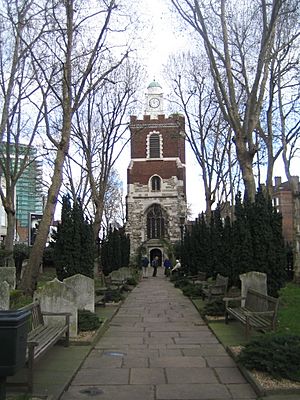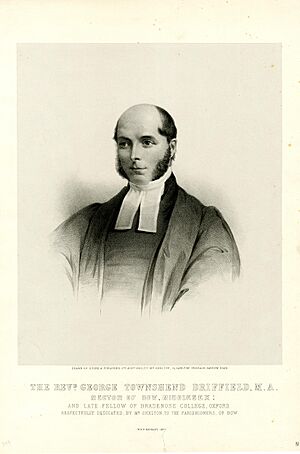Bow Church facts for kids
Quick facts for kids Bow Church |
|
|---|---|
| St Mary's Church, Bow | |

Bow Church in 2008
|
|
| Country | England |
| Denomination | Church of England |
| History | |
| Founded | 17 November 1311 |
| Administration | |
| Parish | Parish of St Mary and Holy Trinity, Stratford, Bow |
| Diocese | London |
| Division | Tower Hamlets |
Bow Church, officially known as St Mary and Holy Trinity, Stratford, Bow, is a historic church in Bow. It stands on Bow Road in the London Borough of Tower Hamlets. People have worshipped at this spot for about 700 years! The church was damaged during the Second World War, but its bell tower was rebuilt soon after.
Contents
A Look Back: The Church's Story
How Bow Church Began
The church started as a "chapel of ease" on November 17, 1311. A chapel of ease was a smaller church built to help people who lived far from their main parish church. Before Bow Church was built, people in Stratford-at-Bow had to travel all the way to St Dunstan's, Stepney for church services. This journey was very hard, especially in winter when roads often flooded.
In the 1300s, the local people felt strong and wealthy enough to ask for their own place of worship. The new chapel allowed them to attend services closer to home. However, they still had to go to St Dunstan's on special religious holidays. They also had to help pay for the upkeep of the main church.
Becoming Independent
In 1497, there was a disagreement about these rules. An agreement was finally reached: the people of Bow would still be considered part of the Stepney parish. They agreed to pay 24 shillings each year to help repair the main church. In return, they did not have to attend St Dunstan's except for two special days each year. On those days, they would join a procession to Saint Paul's Cathedral.
In 1719, Bow Church became its own independent parish. This meant it no longer had to follow the rules of the Stepney church. The area known as Old Ford was also part of this new parish.
Important Events at the Church
In 1556, during the reign of Mary I of England, a sad event happened at Bow. Many people were brought from Newgate and put to death in front of Bow Church. This was part of the English Reformation, a time when there were big changes and disagreements about religion in England. Among those who died were the thirteen Stratford Martyrs.
In 1767, the church became the burial place of Colonel Philip Ludwell III. He was one of the first people in America known to follow the Eastern Orthodoxy faith. Even though Bow Church was Anglican, he was buried following the traditions of the Orthodox Church. The last person was buried in the churchyard in 1854.
The Churchyard as a Garden
The churchyard was later turned into a public garden in 1894. This was done by the Metropolitan Public Gardens Association. A landscape gardener named Fanny Wilkinson designed the garden. She got advice on which old gravestones to keep. The eastern part of the churchyard was designed as a garden in 1911 by Madeline Agar. More recently, 1,500 spring bulbs were planted there, making it a beautiful spot.
The Church Building Over Time
The main part of the church building is believed to be from the 1300s. The tall tower was added in the 1400s. The church is built from a type of stone called Kentish Ragstone, with some brick parts. Many of its windows are in a style called "late perpendicular style".
Inside the church, you can find monuments to people like Grace Amcottes (who died in 1551) and Alice Coborn (who died in 1689). The south side of the church was rebuilt in 1794. In 1896, the roof over the chancel (the area near the altar) fell down. This led to a big repair project.
The church was badly damaged by bombs during the London Blitz in the Second World War. In 1951, Queen Elizabeth visited the site to start a campaign to raise money for repairs. The church was given a special "Grade II*" listed building status on July 19, 1950. This means it is an important historic building that needs to be protected.
Nearby Landmarks
The church gives its name to the nearby Bow Church DLR station. Just outside the churchyard, there is a statue of William Ewart Gladstone. He was a Liberal Prime Minister of the United Kingdom. The statue was paid for by Theodore H Bryant, a wealthy match manufacturer from Bryant and May, in 1882.
The church is still an active place of worship today. In 2011, Bow Church celebrated 700 years of Christian life on its site.
Rectors of Bow Church
Bow became an independent parish in 1719. For about 100 years, from the mid-1700s to the mid-1800s, the rectors (the main priests) of Bow Church all came from Brasenose College, Oxford.
Here is a list of some of the rectors:
- 1719–1740 Robert Warren
- 1740 James Parker
- 1740–1770 Thomas Foxley
- 1771–1801 Allan Harrison Eccles
- 1802–1807 Samuel Henshall
- 1808–1809 Frodsham Hodson (who later became the Principal of Brasenose College, Oxford)
- 1809–1843 Hamlett Harrison
- 1844–1880 George Townshend Driffield
- 1880–1892 William Pimblett Insley
- 1892–1898 Marmaduke Hare (who later became a Dean in Davenport, Iowa, USA)
- 1899 Manley Power
- 1932–1951 George Ansell
- 1961 Francis Mettrick
- 1989–2011 Michael Peet
- 2012–2018 Debbie Frazer
- 2019– Timothy G. May


